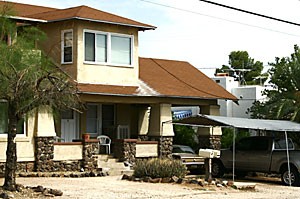A pilot program to address housing and zoning issues around the UA is in the works, with the program receiving initial proposal at the Aug. 6 mayor and city council meeting.
The program, named the University of Arizona Pilot Overlay Zone, was developed in response to the need for housing around the UA. This need for housing has led to the building of large rental units, termed “”minidorms,”” in the historic neighborhoods around the UA, said Jaret Barr, assistant to the city manager.
These minidorms typically do not keep with the historic characteristics of the neighborhoods surrounding the university.
The zone affects only neighborhoods within a 2-mile radius of the UA that are on or are eligible for the National Historic Register. There are 22 neighborhoods that meet these criteria, according to Mayor and City Council memorandum that addresses the issue.
The UA Pilot Overlay Zone has two components.
The first component would allow neighborhoods the opportunity to be included in a design overlay zone, which would acknowledge the historic characteristics of the neighborhood, said Jim Mazzocco, a planning administrator.
Then, the neighborhood would volunteer to create a design manual that would be approved by the director of the Department of Urban Planning and Design, according to the memorandum.
The design manual recommendations would need to be followed for any new building in the neighborhood; these include any addition of 50 percent or more to an existing structure or any additions of a second floor that would be visible from the street, Mazzocco said.
These design considerations would be enforced when builders applied for permits, Mazzocco said.
The second component of the program seeks to identify areas where higher-density housing, such as minidorms, would be built, Mazzocco said. Areas along major transportation corridors, such as bus routes or the proposed streetcar line, are being considered, Mazzocco said.
It could be as extensive as identifying pilot projects or simply identifying areas that would be appropriate for higher-density development, Barr said.
“”At this stage we’re not quite sure how extensive the second component is going to be,”” Barr said. “”We’re still considering that.””
Eligible neighborhoods would have to opt into the program by including their interest in a written proposal.
The Jefferson Park Neighborhood Association, which is located in Ward 3 of the city and is bordered by Grant Road on the north, Lester Street on the south, Campbell Avenue on the East and Euclid Avenue on the West, is planning on choosing the pilot overlay zone, said Bob Schlanger, vice president of the Jefferson Park Neighborhood Association.
While the program focuses on the historical aspects of neighborhoods, Jefferson Park has been feeling other negative effects from minidorms in their area.
“”Students aren’t compatible with normal people,”” Schlanger said. “”In general kids have no respect for the neighborhood – they’re transient. They’re not going to be there next year.””
Schlanger thinks the proposal is not sufficient in its present form. The proposal needs to deal with the density of housing rather than the historic characters, he said.
Proposition 207, which passed on the ballot last November, is also a factor in the proposal. The city fears potential lawsuits if zoning is changed, Schlanger said.
Proposition 207 states that homeowners may be compensated if their property value is reduced following the enactment of a land-use law, according to Legislative Analysis of the proposition.
“”There was a lot of concern in the neighborhoods regarding minidorms,”” says Karin Uhlich, Council member representing Ward 3 neighborhoods, which include Jefferson Park. “”Just a concern that the city be more proactive in partnering with the university so that student housing is appropriately scaled and integrated into the surrounding areas.””
The city and the UA will be working together on both components of the issue in the future, Uhlich said.
Recommendations on the issue will be presented to the Mayor and Council around Oct. 23, which is a working date at this time, Barr said.









